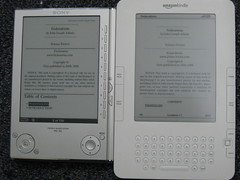This Wall Street Journal article touched many nerves for me: Publishers hold back e-books.
So hold on, I’m going to get a bit ranty and this’ll probably be a long post 🙂
Summary: Two major publishers have decided that they’re going to hold back e-book versions of their titles for months after the hardback release.
From the article, here’s their justification:
“The right place for the e-book is after the hardcover but before the paperback,” said Carolyn Reidy, CEO of Simon & Schuster, which is owned by CBS Corp. “We believe some people will be disappointed. But with new [electronic] readers coming and sales booming, we need to do this now, before the installed base of e-book reading devices gets to a size where doing it would be impossible.”
A much better (and more profitable) course of action would be to simply embrace the e-book world and figure out how to adapt to this new ecosystem. Change is coming, and burying their heads in the sand isn’t how publishers will survive.
Some publishers try to make the argument that people have had the choice to buy a hardback immediately or wait for the cheap paperback for decades. And surely placing an e-book release between those two options just extends this model, right? They have this nonsensical vision that people with e-book readers will run out and buy hardbacks instead when their e-books are taken away. This could not be more wrong. Here’s what’s going to happen instead:
Meet Consumer Bob. Consumer Bob invested a lot of money in a Kindle. He obviously bought the device because he wants to read books on it, right? So Bob hears about a new book on TV and thinks he’d like to read it. Bob can’t find that book for his Kindle. At this point, Bob will do one of two things:
A)If Bob’s tech-savvy he’ll pirate the e-book he wants. Publisher gets no money.
B)If Bob isn’t tech-savvy he’ll buy another e-book to read, and probably forget the first book ever existed. Possibly a different publisher gets money.
Bob spent $250+ on his Kindle, and you better believe he wants to get use out of it. After plunking down that chunk of change, buying a paper book can feel a bit like wasting money. As a Sony Reader owner, I feel this sometimes myself. But Bob is also used to instant gratification and instant delivery of e-books, and doesn’t want to wait for the print version to arrive by mail or a trip to the store. Bob likely isn’t going to change his habits.
But let’s go back and look at part of that article quote again:
“…we need to do this now, before the installed base of e-book reading devices gets to a size where doing it would be impossible.”
What? Consumers are finding something new they want, and your response is to deny it to them? How does that make any kind of business sense? With that attitude you deserve to hemorrhage money.
Another article quote:
“Even as the retail price of many new hardcover novels creeps above $27, Amazon and Barnes & Noble boast many new best sellers for only $9.99 in the e-book format.
Increasingly, publishers have come to fear that the bargain prices will lead consumers to conclude that books are worth only $10, or less, upsetting the pricing model that has survived for decades.”
You know what? They’re right. A DRM-locked e-book simply isn’t worth $27. It’s barely even worth $10. I’m not going to pay the same amount for an e-book that a paper copy would cost me, when I can actually do LESS with that e-copy than the print: I can’t loan it, resell it, or donate it. So I will never ever pay full price, or near full price, for a DRM-locked e-book. Ever. And anybody who does hasn’t thought things through. I’d only consider buying DRM books with a massive (something like 75% or more) discount over the print version, unless the e-version has some other equally massive advantage.
But publishers even shoot themselves in the foot when they stumble on an e-gold mine. Stephen King’s new book, Under The Dome, is over 1000 pages. I don’t want to lug that back-breaking monster around with me, especially on the bus. I want to have it on my phone or e-book reader. This is a case where an e-book has clear convenience advantages over a print version, maybe even enough to overlook DRM issues. I was planning on buying it.
But King’s publisher, Scribner, has decided to shoot the e-book in the head. And not once, but twice. First the e-version won’t be available until 12/24, a full six weeks after the print version was released. Second, they’re charging wholesale prices for the e-book to distributors (like Amazon and B&N) of $35.
My moral outrage from their pricing issues aside (there’s no way they’ll ever convince me that it costs the same to print and ship an e-book as a print book), I REALLY don’t want the massive print version. No matter how discounted it is. So I’m left with just one option to acquire the book legally: Buy Under The Dome as an e-book on 12/24. This is the exact same end result as if the book was released the same day as the print version, 11/10. All Scribner has done is provided me with 6 weeks to forget that I want the book. 6 weeks to find something else to read, or maybe run across negative reviews and decide I don’t want the book after all. A thousand things could make me change my mind about buying the book. Forcing me to wait gains them nothing, and only introduces unnecessary risks into the question of whether or not they’ll get money from me.
And meanwhile I hate to break it to them, but despite Scribner’s best efforts Under The Dome is available as an eBook right now. It’s been pirated, of course. A quick search of the web shows a pirated version, likely scanned in by a large cooperative group, freely available all over the web (and with no DRM!). So Scribner has created an ecosystem where piracy is literally the only option for potential customers who would otherwise line up to give them money, AND that piracy delivers what’s actually a superior product with no DRM. King is a high profile writer with die-hard fans who want his book immediately, not six weeks from now. What are they going to do?
The sad thing is that Scribner will likely use this piracy situation as supposed evidence of how the e-book system doesn’t work and is killing the publishing industry. And they’ll never even see through their own fear, uncertainty, and doubt to realize that the root causes live in their own backyard.

